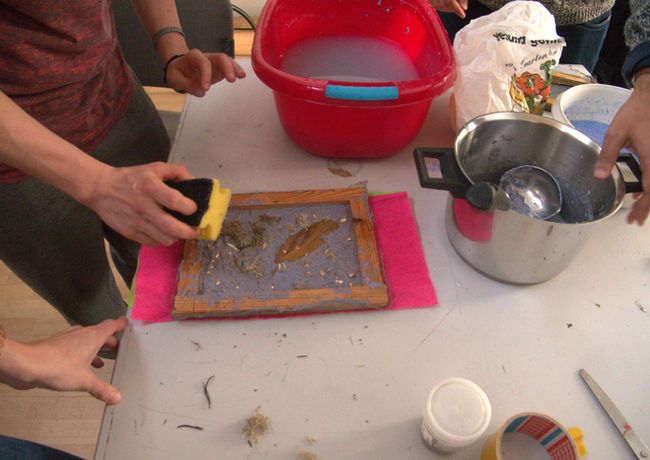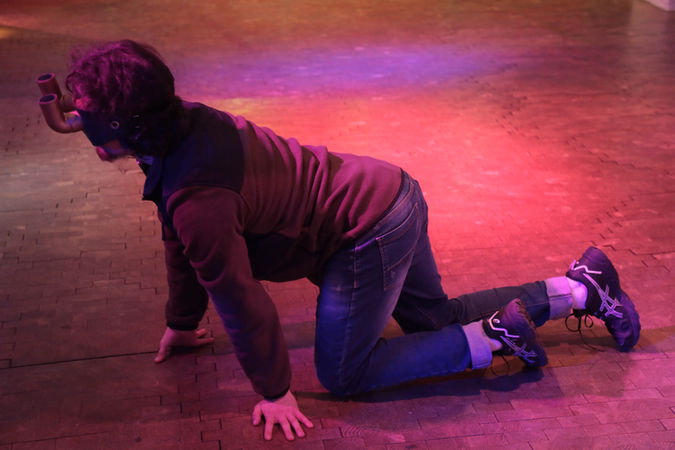Itinerant geographies- a proposition for radical unbelonging (2023)
A curatorial and pedagogical project by Diana De Fex
I invited a group of friends and colleagues to unbelong together—to respond, through their practices, to the idea that gardens and gardening could serve as a lens, a place, a set of practices, an impetus, or even a system for exploring questions of belonging and estrangement. This invitation led to an exchange of practices: first, among ourselves for a week in Frankfurt am Main, and later, in Berlin, where we engaged a wider public.
Supported by Fonds Darstellende Künste with funds from the Federal Government Commissioner for Culture and Media within the program NEUSTART KULTUR. In cooperation with Oyoun.
Why unbeloging?
Unbeloging is a response not only to state coercion, but also to the identity politics and determinisms that have become hegemonic within the alternative cultures of the global North—often sidelining the multiplicity of epistemologies from the global South.
Why together?
I approach this project through the lens of affective curating (Kekena Corvalán), which she defines as “a device to show us in our contradictions [...] guided by an affective logic rather than market logic [...] While contemporary art seeks enunciation (singular), affective curating seeks enunciations (plural, collective), always emerging from our contradictions.”
To unbelong together radically means embracing uprootedness and estrangement as sites of curiosity and knowledge, fostering an empathy that risks one’s own identity—even one’s future. It is, in other words, imagining other ways of being together and creating collectivity.
Why gardens?
Since the dawn of European modernity, gardens have been conceived as utopias—spaces where communion with nature and sensory pleasure could be reclaimed. Aristocrats replicated Italian landscapes in English gardens, while public gardens offered the working class a semblance of the same experience. Ironically, these green counterpoints to industrialization were often funded by its very architects.
Yet gardening, as a material practice, is far from utopian. Utopia, by definition, never arrives; it is perpetually deferred. Gardening, however, engages the present—tied to potentiality (what could be) and failure (what could have been). In The Gardener’s Year, Karel Čapek depicts the gardener as a caretaker of fragility, perpetually confronted by helplessness: a root torn by over-plowing, buds ruined by unseasonable snow.
Similarly, I position my curatorial practice as a counter-narrative to contemporary art’s canon, which Corvalán calls a “factory and fortress of utopias.” If mainstream curating is driven by market competition, affective curating is moved by “the dispute for territories.”
The shared practices
Mapping as a dreaming device
With Diana De Fex
Starting from a conception of landscape in an expanded form, which can be rural or urban, microscopic, pictorial, sonorous, tactile, etc., and maps as devices for dreaming and creating new territories (as opposed to objective representations of reality), this is an invitation to feel-think the landscape we inhabit and that inhabits us, through a practice of interpersonal and collective mapping. Through interpersonal and collective mapping practices—guided meditations, collaborative drawing, deep listening, and explorations of touch and bodily movement—we engage in a perceptual dialogue: a continuous, reciprocal exchange where we shape our surroundings just as they shape us, blurring boundaries and co-authoring textures of meaning.
Initially developed during an artist residency at Tribu Trueno in Bariloche, Argentina (January-February 2023), with further iterations/developments at Spore Initiative in Berlin (June 2023), Sommerwerft Festival in Frankfurt am Main (July 2023) and Garage Ost in Leipzig with the support of Leipzig Kulturamt (November-December 2023)

Memory gardens
with Olga Popova
In this workshop, we approach gardening practice through the process of remembering, sharing, and socializing.The first two sessions are dedicated to the practices of remembering through recreating our childhood and adolescence gardens. You are invited to time travel, which should help you establish a connection to all these forgotten details, smells, feelings, and stories related to your personal memory gardens.Along with the collection of stories, we gather plants and seeds that relate to our gardens and think about the possibilities of making a common garden. Through this intimate practice of echoing, we approach the actual gardening practice, which happens in the Oyoun garden on the last day of the workshop.

Embroidery on leaves
with Maria Tsitroudi
In this workshop, we practice embroidery on leaves. It is an invitation to a collective creative social experience. This practice connects with my early childhood memories, remembering my grandmother and her female neighbours. They would meet on a daily basis, visiting each other's kitchens to knit or practice embroidery together. These women shared a common history. All of them were Greek migrants from the coast of Minor East. When they wanted to say something secretly, they would talk in Turkish. Knitting and chatting were a way of creative sociality. All of them were extremely skillful. It was shared knowledge that they developed together while growing old together. Their neighbourhood was their home, and it was bound to their social identity.Recalling this memory, I ask myself what is lost by losing the sense of neighbourhood and the sense of continuous temporal and spatial experiences, while it makes me realise that the sense of home cannot exist without the sense of community.

Word compost
With Fabian Franco
Compost is the leftover from food that we consume, a piece of wood, forest litter, the lost hairs of a cat, a key without an owner, or something that was and is no more. Waste, in its optimal conditions, transmutes to become the nutrients of the soil ecosystem.
Could we turn our words, difficult moments, and misconceptions into compost to plant new ways of perceiving the world?
We take a letter from the health insurance, a letter from a debt collector, from the Job Center, a bad message, or an old perception, and if you don’t have a letter, you can just write something or draw it. We cut with our hands, destroy and discard the information that lies on the paper, and we give it another use. Shred it with the blender, and let the information mix with the water. Then we filter the mixed information through the sieve and squeeze out the water until the new paper is almost dry. We plant seeds on the paper, draw, write a letter, or let it be a simple and beautiful handmade paper as potentiality.

Interactive Installations
With Nitish Jain
Cartography of a disappeared cosmos
This is an interactive installation and participatory research. We map, trace, and plot a space—a cosmos—using our bodily senses instead of mental reasoning. In order to map the "disappeared," we pay attention to our subjective experience and disregard the pursuit of an objective truth. As such, we simultaneously map an ancient river that disappeared 12,000 years ago from the realm of seen things as well as the night sky 200 years from now—bright with artificial light but without any stars visible. We use the senses of touch, sound, and very limited sight.
Each cartographer is equipped with a pair of chromoculars—an ocular tool that allows you to sense only light and color, while shapes and forms disappear. Participants wear the chromoculars and walk the space, aided by lights and music, engaging their hands with tactile ropes for guiding, orienting, floating, walking, dancing, or resting; mapping the river and the night sky.

The Forest indoors: moss carpet for feet
As part of the research on "unbelonging," a moss carpet is installed under one of the tables in the Café at Oyoun. The carpet provides a tactile experience for visitors' feet. You are welcome to bring your book, computer, work, companions, or hobbies with you; sit around the table without shoes on, and stay with your feet on the carpet for as long as you wish. Or, you can also simply bring your attention to your toes, heels, and soles.
Historically, carpets represent gardens—the idea that a carpet is a garden that can move across space. Using a carpet-garden made of stabilized moss, a material that has been displaced, altered, and repurposed, the objective of the research is to observe personally what (and if) physical contact with repurposed nature, while being indoors, does to well-being.









































